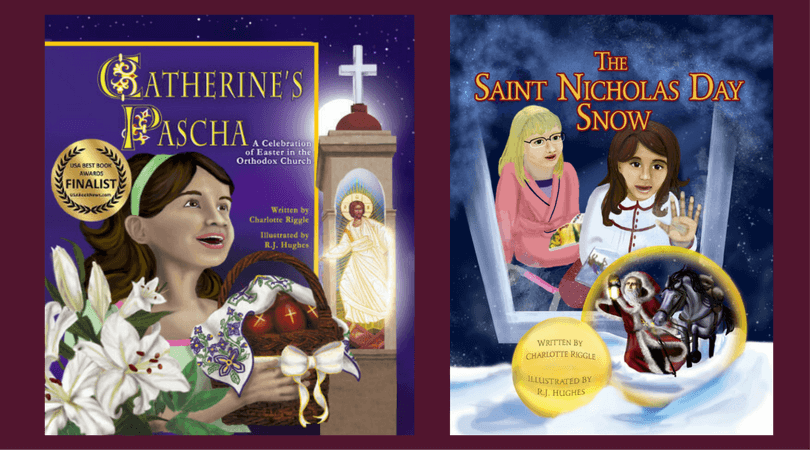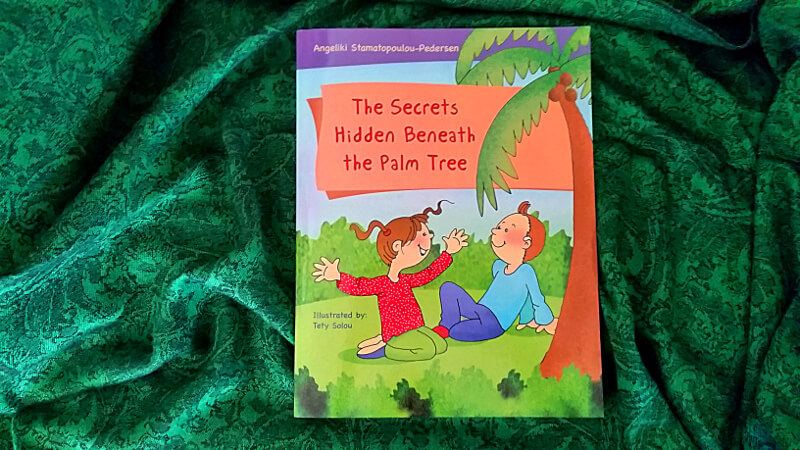I’ll start with a disclaimer: I love Angeliki Pedersen, author of The Secrets Hidden Beneath the Palm Tree. We attend the same parish, and I think I must have met her the first time we visited here. She’s the kind of person that reaches out to strangers at coffee hour and makes them feel welcome.
As Angeliki and I got to know each other, we learned that we’re more than just members of the same parish. We’re also members of the community of parents of kids with disabilities. We’re not young, either one of us. Our kids are grown. But once you’re part of that community, you’re in it forever.
And, unbelievably, we’ve both written picture books! Both of us, when our children were small, wanted specific picture books for our own children, and the books we wanted didn’t exist. I wanted a book about a child celebrating Pascha. She wanted a book about a child who is deaf.
So we both did what so many parents do, when they want a book that is “too niche” for mainstream publishers. We wrote the books we wanted. I didn’t publish mine right away. It wasn’t for lack of trying. But I had to wait more than 20 years, for a revolution in printing technology and the rise of the micropress to find a publisher for Catherine’s Pascha.
It didn’t take Angeliki nearly that long!
The story behind the book
Although Angeliki had been living in the US for many years when wrote The Secrets Hidden Beneath the Palm Tree in 2006, she is from Greece. Her native language is Greek. So she wrote her book in Greek. And because it is a nonfiction picture book about deafness, she submitted the manuscript to the department of deaf studies at the University of Patras in Greece. She thought they might be interested in it.
And she was right! The university invited her to be part of a parents’ panel, and to present her book at a conference. They also wanted to publish the book and to use it in their annual summer workshops for elementary school teachers.
Unfortunately, that was just before the Greek economy suffered a serious downturn. The university lost funding for their workshops, and the illustrator lost her business. So, in 2011, Angeliki decided to self-publish her book in Greece.
And just last year, she decided to translate her book into English. And I’m so glad she did! I don’t read Greek, and without the translation, I wouldn’t have been able to read Angeliki’s book.
A book about deafness
Nonfiction picture books about medical conditions are an important genre. They provide medical information in the form of a story. They make the information warm and personal, and easier for a young child to understand.
If you’re as old as I am, you might remember Security Is an Eye Patch, a picture book in which Charlie Brown and his sister Sally provided information about lazy eye. Noah the Narwhal is a book about chronic migraine. There are many other books about many other conditions.
You’re more likely to find these books in a medical office than in a bookstore or library. In fact, Angeliki donated most of the copies of the Greek edition of The Secrets Hidden Beneath the Palm Tree to speech pathologists and teachers that worked with deaf children.
In the book, a little girl named Angelia is curious about her classmate Jacob, who is deaf. Jacob briefly explains what hearing aids and cochlear implants are. He explains what audiologists and speech pathologists do. Along the way, the book provides tips on how to talk so that a deaf person can understand you more easily. And it even has suggestions for arranging and managing a classroom to ensure that a deaf student is included.
If you should be fortunate enough to find a copy of the Greek edition, you’ll find that it is rather different from the English version. For one thing, it rhymes. The English version doesn’t. For another, it includes reference material about hearing loss for parents and teachers. Angeliki didn’t include the reference material in the English version, because, she said, that information is readily available in the US.
But that doesn’t mean that everyone understands deafness and hearing loss. If you’re looking for an adult perspective on the subject, read Hearing loss isn’t silence, at church or anywhere, a guest post by Lola J. Lee Beno.
Read More
The best picture books with disabled characters: You’ll find more picture books with deaf characters in this list.
Hearing loss isn’t silence, in church or anywhere: In this guest post, Lola J. Lee Beno talks about different kinds of hearing loss, and how hearing loss can affect your fellow parishioners.
9 steps to an autism-accessible home library: Guest writer Summer Kinard explains how she’s created a home library that works for her autistic children.
Buy the Books!

These delightful books will diversify your bookshelves with disability representation. Elizabeth, one of the main characters, is an ambulatory wheelchair user.
Catherine’s Pascha
FINALIST IN THE 2015 USA BEST BOOK AWARDS
Catherine doesn’t like vegetables. She doesn’t like naps. She doesn’t like it when her mom combs her hair. She loves hot dogs, chocolate cake, and her best friend, Elizabeth. Most of all, she loves Pascha! Pascha, the Orthodox Christian Easter, is celebrated in the middle of the night, with processions and candles and bells and singing. And Catherine insists that she’s not a bit sleepy.
Celebrate the joy of Pascha through the magic of a book: Catherine’s Pascha. Available on Amazon, Bookshop.org, and my webstore.
The Saint Nicholas Day Snow
Shoes or stockings? Horse or sleigh? Does St. Nicholas visit on December 6 or on Christmas Eve? Will a little girl’s prayer be answered? When Elizabeth has to stay at Catherine’s house, she’s worried about her grandmother, and worried that St. Nicholas won’t find her. The grownups, though, are worried about snow.
Celebrate the wonder of St. Nicholas Day through the magic of a book: The Saint Nicholas Day Snow. Available on Amazon, Bookshop.org, or my webstore.




Dear Charlotte Rggle,
Thanks for this very accurate and well written presentation of
both the author, Angeliki Pedersen, who is a good friend
of mine from the time she was
living in Connecticut, and her
book.
Thanks my dear friend Athena. Your opinion and many years of experience as a teacher, a Sunday and Greek school director in New Haven CT. is very valid. Please look at Charlotte’s books. They are a wonderful addition to any Orthodox community
Dear Charli,
I feel enormously grateful for your wonderful review of my book.
Timely advocating and support for our children with hearing loss is so essential and should be universal. Thank you again for contributing with your sensitive writing.